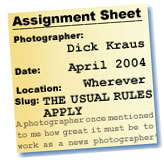ALL
OF THE USUAL RULES APPLY
by
Dick Kraus
Newsday Staff Photographer (retired)
A photographer once mentioned to me how great it must be to work
as a news photographer. His reasoning was that we didn’t
have to worry much about good photography since most of our work
consisted of news “grab” shots.
When I tried to explain to him that all of the usual rules apply,
even in spot news photography, he regarded me as though I had two
heads. I tried to tell him some of the things that the Director
of Photography at my paper told me when he hired me as a staffer,
many years ago.
The first lesson was that the only reason for any image I make
to be on the page of a newspaper is to capture the reader's attention
and stop him/her from turning the page. That might get him/her
to read the caption and then, hopefully, to read the story.
He went on to explain the misconception that many people have.
They think that because newspaper reproduction is so bad many people
feel that it isn’t important to try to introduce quality
into the picture from the onset. The paper is printed on a stock
that can only be regarded as a minimal improvement over toilet
paper. The letter presses that were used in those days just crushed
blobs of black ink onto the lousy newsprint and the resulting images
were fuzzy and smeared, at best. But, my mentor explained, it was
important to start out with a superior product from the very beginning
so that the subsequent degradation of the image as the printing
process continued, would at least leave something recognizable.
He also insisted that his staff observe all of the standard rules
of good photography, starting with good composition, sharpness
and good contrast, proper exposure and above all, relevance.
Most of the work we do is not in the spot news genre. So, we do
have the luxury of looking around for a clean background. We can
move about to locate good composition and we can try different
focal length lenses to create interesting perspective. We can use
tripods for long exposures and flash to light the scene. There
is certainly no excuse for submitting inferior photos to our editors.
Even during spot news situations, when the scene may be chaotic
and ever changing before our eyes, an experienced pro will keep
his/her eyes open for an angle that will portray the event in a
more appealing fashion. Next time you are at a breaking news story,
watch the other photographers in action. Most of them will clump
together and shoot the same scene from the same angle and with
the same focal length as their competition. But, there may be one
or two mavericks who will shoot the “safe” scene and
then scramble to look for a better angle.
While every situation might not lend itself to a well composed
photograph, you can generally perk up the scene with some “foreground/background” imagery.
Or you can try a low angle “deck” shot for a different
perspective. Sometimes you can jazz up a dull photo with a long
focal length lens, or maybe a very wide angle view. You can look
for some interesting design element to introduce into your shot
to liven it up. Ah yes, my friends. All of the usual rules apply.
I would invite you to look at some of the photos I am about to
show you. They are pictures that I have taken over the years as
a staff photographer for a daily newspaper. Many of the stories
and subjects were about ordinary people in ordinary situations.
When I arrived at the location, I would size up the situation and
look for things to make my photos interesting. Sometimes I had
props, sometimes I didn’t.

© Newsday Photo by Dick Kraus
The
photo of the deaf/blind man was about the teaching
tools that were used to teach someone who cannot see
nor hear how to use sign language that is sensed by
touch rather than seen. There were plaster casts of
each sign, complete with braille lettering. I arraigned
the casts in an interesting composition and then used
a dramatic lighting to emphasize the subject. |
|
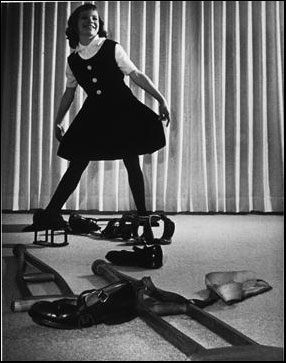
© Newsday Photo by Dick Kraus
I
did pretty much the same thing with the young girl
who was born with a deformity and had to use the
various prothesis's as she grew up and eventually
was able to discard them. |
|
© Newsday Photo by Dick Kraus
” Spring
Walk” was just an ordinary weather shot. Not
much to work with, but I liked the gentle “S” curve
that was part of the scene and worked it into my
composition. |
|
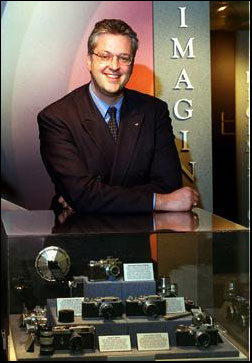
© Newsday Photo by Dick Kraus
“Canon
VIP” was for a story on the Vice President
of Canon, USA, and there was a show case of old Canon
cameras available so why not use it. |
|
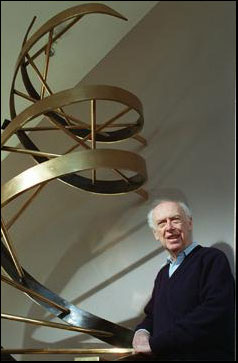
© Newsday Photo by Dick Kraus
Dr.
James Watson won a Nobel Prize winner for his discovery
of the “double helix” of DNA. I needed
a shot of him at his Cold Spring Harbor (NY) laboratory
and there in the hall was a model of the double helix.
The low angle made it more dramatic. Plus, it was
the only way I could include all of it and still
have the man large enough to be recognizable. |
|

© Newsday Photo by Dick Kraus
The
photo in the cemetery was done in Normandy, France
during our coverage of the 50th Anniversary of D
Day. The subject was a former German soldier who
had fought on Omaha Beach where American GI’s
were landing. He went back to Omaha Beach every year
and would go to the German Military Cemetery there
to pay his respects to his fallen comrades. The cemetery
was filled with these large Teutonic crosses. I shot
the scene from many angles, but it wasn't until I
put on a 15 mm lens and laid the camera on the ground
right next to the grave markers, did the scene come
to mean something. |
|
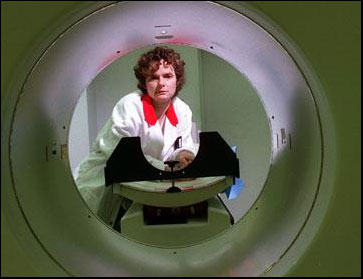
© Newsday Photo by Dick Kraus
Every
photographer who ever had to photograph a CAT Scan
has probably framed it through the opening in the
device. I’ve done it many, many times. And
while I hate to shoot the same angle over again,
it just works so well. This was something called
at PET Scan and I made it a little different by lighting
the doctor in a little more dramatic fashion. |
|
The
usual rules DO apply. As news photographers we have two responsibilities.
1. Make a relevant photo that explains to the viewer what the
story is all about.
2. Make that photo as interesting as possible to draw the reader's
attention to it and the story.
If you can do that, then you have earned your daily bread.
Dick Kraus
newspix@optonline.net
http://www.newsday.com
